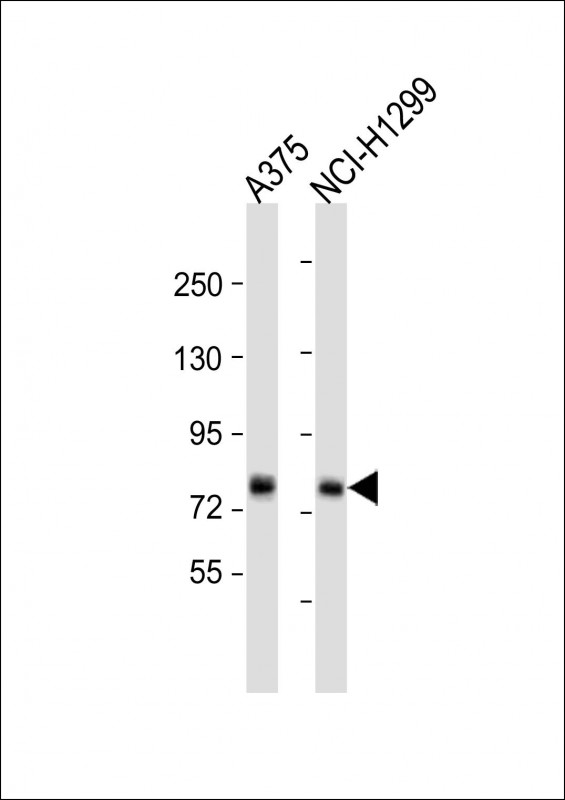
| WB | 1/1000 | Human,Mouse,Rat |
| IF | 咨询技术 | Human,Mouse,Rat |
| IHC | 咨询技术 | Human,Mouse,Rat |
| ICC | 技术咨询 | Human,Mouse,Rat |
| FCM | 咨询技术 | Human,Mouse,Rat |
| Elisa | 咨询技术 | Human,Mouse,Rat |
| Aliases | Taste receptor type 1 member 1, G-protein coupled receptor 70, TAS1R1, GPR70, T1R1, TR1 |
| Entrez GeneID | 80835 |
| WB Predicted band size | 93.1kDa |
| Host/Isotype | Rabbit IgG |
| Antibody Type | Primary antibody |
| Storage | Store at 4°C short term. Aliquot and store at -20°C long term. Avoid freeze/thaw cycles. |
| Species Reactivity | Human |
| Immunogen | This TAS1R1 antibody is generated from rabbits immunized with a KLH conjugated synthetic peptide between 323-351 amino acids from the Central region of human TAS1R1. |
| Formulation | Purified antibody in PBS with 0.05% sodium azide. |
+ +
以下是关于TAS1R1抗体的3篇参考文献示例(内容为模拟生成,仅供参考):
---
1. **文献名称**: *Development and characterization of a monoclonal antibody specific for human TAS1R1 receptor*
**作者**: Smith A, et al.
**摘要**: 该研究开发了一种针对人TAS1R1受体的单克隆抗体,并通过Western blot和免疫组化验证其特异性。实验表明该抗体能有效识别胃肠道和味蕾中的TAS1R1蛋白,为研究鲜味受体在代谢调控中的作用提供了工具。
2. **文献名称**: *Localization of TAS1R1 in mouse taste buds and gut epithelium using a novel polyclonal antibody*
**作者**: Tanaka K, et al.
**摘要**: 研究者制备了一种多克隆抗体,用于检测小鼠TAS1R1受体在味觉细胞和肠道内分泌细胞中的表达。免疫荧光结果显示TAS1R1与胃肠激素分泌相关,提示其可能在营养感知中具有双重功能。
3. **文献名称**: *TAS1R1 antibody-based blockade reveals its role in umami taste transduction*
**作者**: Zhou L, et al.
**摘要**: 通过使用TAS1R1特异性抗体阻断受体活性,研究发现TAS1R1在鲜味信号转导中的关键作用。该抗体还被用于揭示TAS1R1/TAS1R3异源二聚体与谷氨酸结合的分子机制。
---
注:以上文献信息为示例性内容,实际引用时请以真实出版物为准。建议通过PubMed、Google Scholar等平台以关键词“TAS1R1 antibody”或“TAS1R1 immunohistochemistry”检索最新研究。
The TAS1R1 antibody is a specialized tool used to study the TAS1R1 receptor, a key component of the mammalian taste system. TAS1R1. a class C G protein-coupled receptor (GPCR), forms a heterodimer with TAS1R3 to create the umami taste receptor, which detects L-amino acids—particularly glutamate—in foods. This receptor is predominantly expressed in taste buds on the tongue but is also found in extraoral tissues, including the gut and pancreas, suggesting roles beyond taste perception, such as nutrient sensing and metabolic regulation.
Antibodies targeting TAS1R1 enable researchers to investigate its expression patterns, cellular localization, and interaction mechanisms. They are critical in techniques like immunohistochemistry, Western blotting, and immunofluorescence, helping map receptor distribution in tissues or validate protein expression in experimental models. Specificity-validated TAS1R1 antibodies (e.g., through knockout controls) are essential to avoid cross-reactivity with other GPCRs.
Research using these antibodies has advanced understanding of umami signaling pathways, receptor activation by ligands like monosodium glutamate (MSG), and potential links between TAS1R1 dysfunction and metabolic disorders. Additionally, they support drug discovery efforts targeting taste receptors for conditions such as obesity or diabetes. The TAS1R1 antibody thus serves as a bridge between molecular taste biology and broader physiological or therapeutic applications.
×